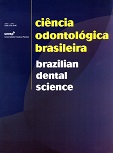Evaluation of apical leakage in root canals filled with different sealers
DOI:
https://doi.org/10.14295/bds.2012.v15i3.820Resumo
Objective: To evaluate the apical leakage exhibited by root canals filled with gutta-percha points and three different endodontic sealers. Material and Methods: Thirty-five human molars were used and had their palatal (maxillary molars) and distal roots (mandibular molars) sectioned, standardized and instrumented with Mtwo rotary system. The roots were filled through active lateral condensation technique and divided into three groups (n=10), according to the endodontic sealer employed: G1- AH Plus, G2- Fill Canal, G3- MTA Fillapex. All groups were filled by gutta-percha points and endodontic sealer. Gutta-percha points were immersed into sodium hypochlorite for 24 h to achieve disinfection. After the filling procedure, the roots were immersed into Indian ink for posterior diaphanization and obtainment of the images through stereomicroscopy. By analyzing the images in Adobe Illustrator CS5 software, the level of apical leakage was determined. The data obtained were submitted to Kruskal Wallis and Dunn tests, with level of significance set at 5%. Results: Statistically significant differences were found between G1 and G3. G2 did not show statistically significant differences. G1 exhibited the smallest apical leakage mean (12.85), followed by G2 (109.84) and G3 (101.15). Conclusions: Root canal obturation with gutta-percha points and AH plus sealer through lateral condensation technique provided lower apical leakage rates than the other endodontic sealers evaluated.Downloads
Downloads
Arquivos adicionais
Publicado
Como Citar
Edição
Seção
Licença
TRANSFERÊNCIA DE DIREITOS AUTORAIS E DECLARAÇÃO DE RESPONSABILIDADE
Toda a propriedade de direitos autorais do artigo "____________________________________________________________________" é transferido do autor(es) para a CIÊNCIA ODONTOLÓGICA BRASILEIRA, no caso do trabalho ser publicado. O artigo não foi publicado em outro lugar e não foi submetido simultaneamente para publicação em outra revista.
Vimos por meio deste, atestar que trabalho é original e não apresenta dados manipulados, fraude ou plágio. Fizemos contribuição científica significativa para o estudo e estamos cientes dos dados apresentados e de acordo com a versão final do artigo. Assumimos total responsabilidade pelos aspectos éticos do estudo.
Este texto deve ser impresso e assinado por todos os autores. A versão digitalizada deverá ser apresentada como arquivo suplementar durante o processo de submissão.




























